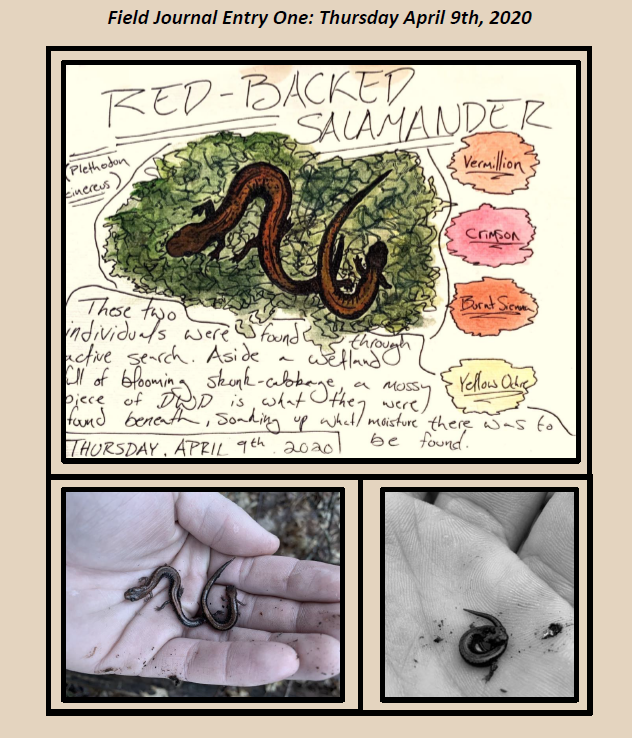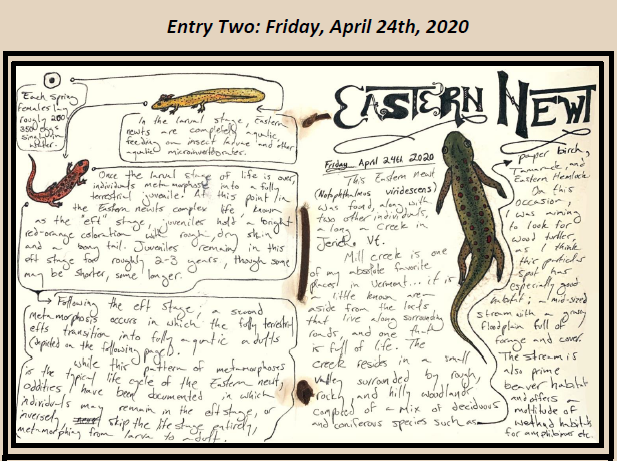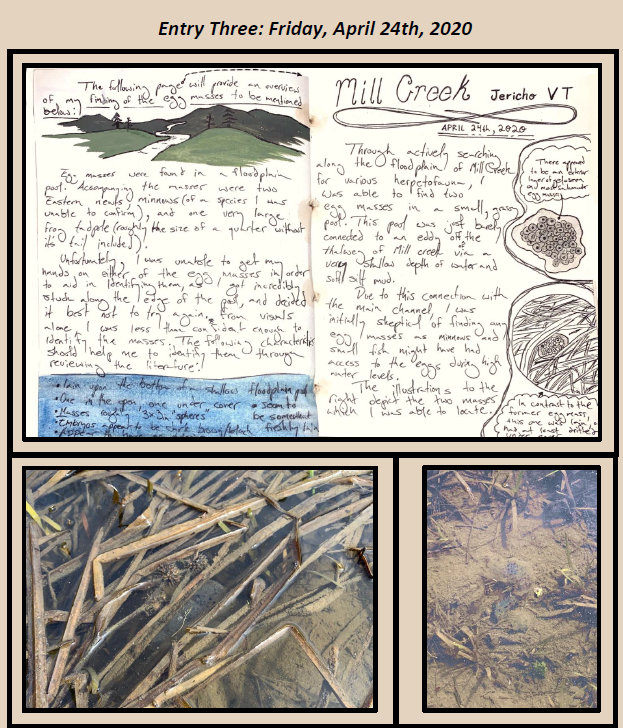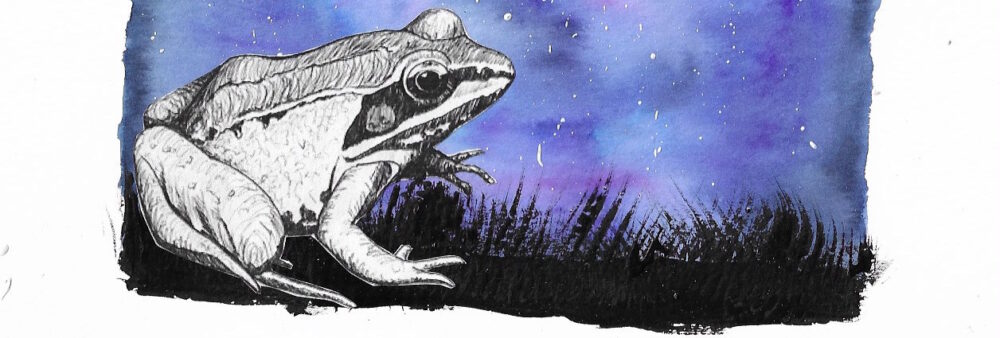Recent UVM graduate Eli Estey combined the idea of a herpetology field notebook with art! What a great way to observe, document, and learn about the natural world.


Eli writes, “This field journal entry is focused around my finding of several Eastern Red-backed salamanders (Plethodon cinereus), including a yearling, in a semi-permanent wetland behind my parent’s property in southeastern Massachusetts.”
“The wetland is settled in a section of mixed deciduous and coniferous forest. Where the water table rises above ground-level, it rarely exceeds two to three inches in depth. Today, the skunk cabbage (Symplocarpus foetidus) was just beginning to bloom, and filled the air with such a familiar aroma, and one that never fails to flood my memory of past visits to the wetlands of my life so far. The forest surrounding this wetland is a mix of forested hillside, a pleasant yet frustrating tangle of hobblebush (Viburnum lantanoides) and witch hazel (Hamamelis virginiana) shrubs, and a fair amount of downed woody debris surrounding the water. A beautiful place to search for salamanders.”

“This field journal entry is focused around my finding of several Eastern Newts (Notophthalmus viridescens), including a two adults, and (I believe) a larval stage individual, though they were quite a speedy little fella, and successfully evaded my clumsy hands. They were truly a pleasure to observe swimming through the water like a single species line Lotka-Volterra model!”
“These newts were found in two different settings in the same river floodplain (that of Mills Creek in Jericho Vt). One adult was found in a slow-moving pool directly attached to the main channel of the stream, though mostly separated by the buildup of silt along the upstream side of an active beaver dam. The second adult, as well as the potentially larval stage individual, were found in a shallow, well vegetated pool further into the floodplain. The pool was also (just barely) connected to the main channel by a narrow strip of centimeter or so deep water. I say that one individual may have been larval stage largely due to its small size, and more yellowish coloration. I was not able to see if external lungs were present or not in the short window I was able to view the individual.”

“As you might have been able to tell by the entry above, I haven’t quite dialed in my egg mass identification skills quite yet! Below I’ll dive in a bit more to what my thoughts are on those eggs found in the field, and what ideas I have about who the culprit might be.”
“When I spotted these egg masses my first thought was to see if there was a thick exterior lining of gel, typical of several native salamander species, or if the eggs individual outlines were easily distinguishable on the exterior of the mass. After looking at them for a while, getting stuck in the muck, and truly wishing that I could have managed to get a hand on one of the masses, it certainly appeared to me that there was an exterior layer of gel. This sent my mind down the path, of “what salamander species would lay these, here in a small, vegetated pool in the floodplain of Mill Creek?”. I’m sad to say that I’m still a bit uncertain about the answer to that question. Hopefully you’ll be able to provide some insight Brittany!”
“After establishing that I believed the eggs to be those of a salamander, though I was not certain of that to any extent, I began to take additional notes on the characteristics of the masses that might aid in their identification. I noted first that one was in the open water, and the second was under the cover of grass, though neither appeared to be attached to any sort of structure (twig, blade of grass or otherwise). Next I noted that the masses were both about 3inch by 3inch orbs, and that they didn’t appear to be freshly laid. I noted that each individual egg had a blackish embryo that appeared to be uniform in color as best as I could tell, and that the clear portion of each egg was about as wide as the embryo on either side. Once I was able to jot down as many notes as I could think of, I began to ponder possible species. First I tried to think of what Caudata species would be most likely to be present in the habitat. The following came to mind: Spring salamander, Eastern Newt, and Northern Dusky salamander… none of which quite fit the characteristics of the eggs.”
“All in all, I left the field still a bit perplexed as to what species might have laid the eggs, and wished that I could have felt more confident towards any one species, or even one Order for that matter. I’m still a bit confused as to who would have been the most likely culprit in this scenario, and would love to hear any insights you might have Brittany! Thoughts on what I could have done better in trying to ID the masses, steps I might have forgotten in my process, or any other words of wisdom!
… with that, here is my Herpetological Field Journal of the past several weeks, I look forward to flipping rocks, and logs, turning bark, and monitoring road crossings as the weather continues to warm!Best Wishes, Eli”
